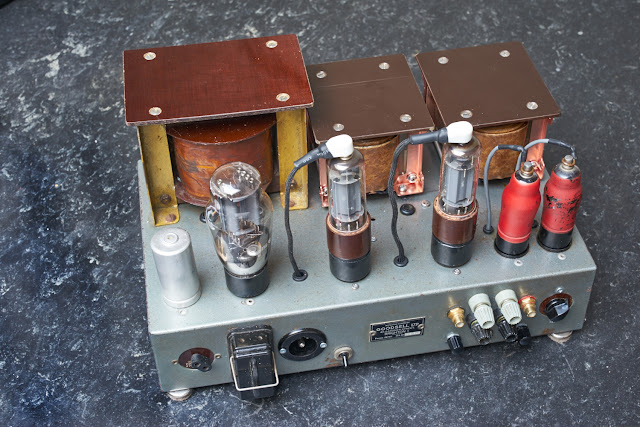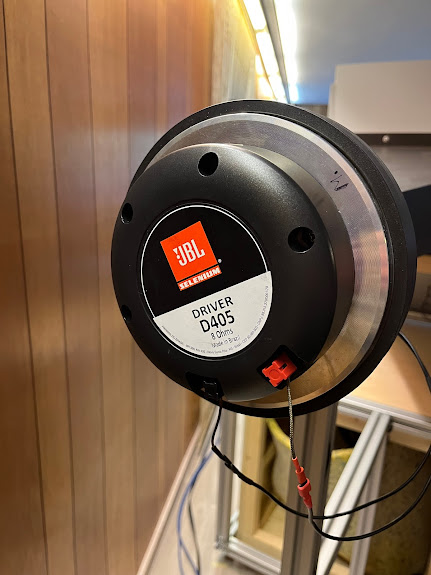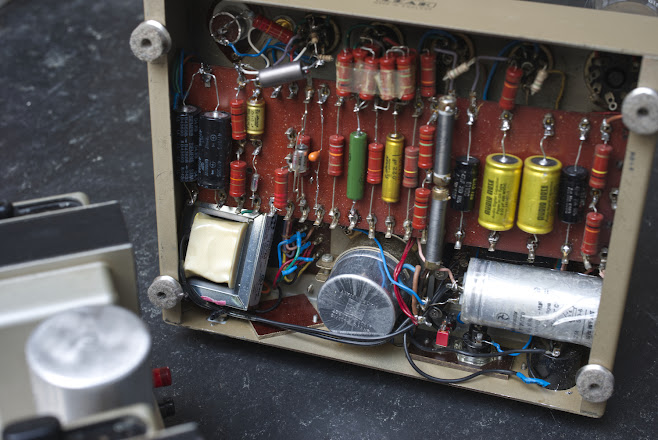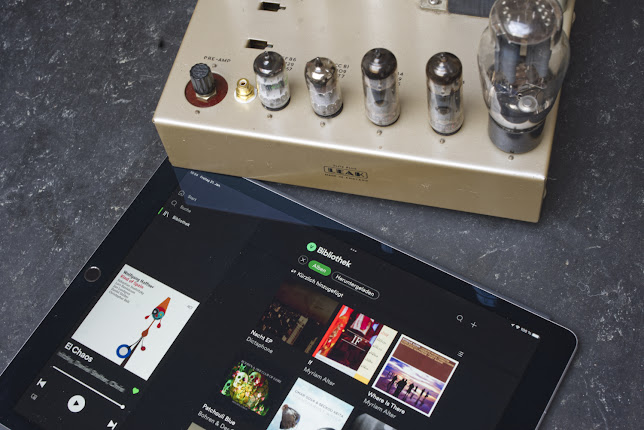End of 2017 I did
publish a post about the single ended amplifier designs and my evaluation of power tubes to be more than an alternative of the
Western Electric 300B tube. In these days the idea formed from my earlier sound evaluation experience of different manufactured 300B tubes. The audio business focused on tube amplification made single ended tube amplification designs with 300B power tubes for 40 years to be
the "cash cow" of growths. As result there are uncountable amounts of makes and brands in the market which explain each as the most original reproduction derivate of the original
Western Electric power triode
WE 300A from the 1920ties. The major problem here are the extremely developed market values of original vintage rare
WE-tubes from all production decades and as reaction to such rareness the market mechanism highly raised the price tags. So modern production tubes create an own market, such are made in different countries but foremostly in China (to keep the quality level high, lol). As earlier stated, if you are not millionaire, able to light your
Cohibas with 100$-notes, the modern replacement tubes in the 100 to 600$ range are all more or less
crapfunctional in comparison to vintage tubes from the 1940ties in + 2000$/pc range. So relevant amplifiers of the traditional WE91A design topology use on top the WE310A as driver, the WE274B as rectifier, all together the equivalent for stereo in the 10K$ range and if you really want the exceptional finesse of sound, – alternativeless.
Yet, the single ended amplifier topology shows up to the tube audio connoisseur with several advantages if you incorporate a lightweight, fast and fine detailed alnico magnet driven loudspeaker, like horns and full range paper cone speakers (like Altec 755 or similar) or combinations from both principles. To raise the full potential of such systems the amplifier design is in need of radical control about component quality and about its consequent amplification topology. Today almost all decisive vintage components of quality production have disappeared from the market, so it is almost impossible to realize an amplifier design without any compromising cut or ending up in the cost nirvana (known from several Japanese brands reissuing modern
Western Electric equipment at a highest possible level). Such set ups easily might create levels of investment in the million dollar range. If you are not the successor in the Toyota heritage or the son of an Arab prince, it might get a bit difficult to follow up such ways to your hobby within the coming years. For all others it needs some intelligent liberation from hardly traded positions in order to find perfect new ways to comparable sound qualities. Here I am going to describe my second sample to a wishless audio happiness with tube amplified equipment, where the tube line up for stereo matches the amount for a well cared piece of organic breeded beef. Yes, 50 $ and all tubes are vintage NOS highest quality production standards long life types or military grade, – and on sale in good amounts.
I am still in the good position to have several of necessary vintage quality parts as spares stored in my cellar, so I am able to realize rarely a design with almost ideal components. My first sample of such conception from 2017 earned so much interest that I did decide to realize a second version build on an identical design topology but realized with completely different hardware, a interesting step to find out about resulting differences.
 |
| Partridge mains transformer beside modern open frame output transformers, all covered by epoxy resin boards, like several British vintage amplifiers show up with |
Here I did finalize an early
Ebay finding after more than 20 years, a British
Goodsell GW12 Williamson PP design from 1949, which had lost its open frame
Partridge-output transformer. I did look for years to complete it again or to find a matching partner for stereo use, which never happened by its exclusive rareness. So I decide in 2005 to break off the originality line with a heavy heart, but at least in order to bring it back to a new functional life as a single stereo ended amplifier. In these days I did experiment with another rare find, the DHTs from
Elektromekano S6 in order to resemble the classic 300b out put tube in such designs. I used the
Mullard EF37A to be the driver tube and tested several output transformers to complete this concept, but nothing could convince my expectations in these days (and the illustre matching preferences of this extreme tube). It ended up that I stored the chassis back in my cellar and followed up other ideas like DHT tubes in preamplification stages and so the Goodsell SE-amplifier got more or less forgotten.
 |
| The Danish 1940ties Directly Heated Triodes from Elektromekano, the S6 and M7 (4V/1A) are some of the finest manufactured power triodes made ever. Even the Western Electric types from this period don't match mechanically their standard. Unfortunately these triodes don't match the ordinary range of output transformers but they are still some of the nicest Tube ever. |
 |
| at the far right the knob for the global feedback loop, realized with single switchable carbon composition resistors |
Last autum I did start a collection sale of all my long time collected amplifiers and other audio collectibles in order downsize my life in a "less is more" matter. So I had several people coming to look and listen to different components of my personal estate. Many of such auditions ended into sales of exceptional sounding vintage valve amplifiers and dedicated components like speakers, preamplifiers, tonearms, etc. But the most respect raised after end of a particular sales procedure when the question came up with which amplifier I am going to listen in the future? When I demonstrated the
"bastard amp" in my favored chain, the most people didn't need a lot more than a minute of listening to understand my decision. Within the two gone years of time the interest into such a special single ended tube amp has grown. So I thought about another sample, well knowing that the prototype was some sort of recycling of leftovers on a highest level possible. I did exactly know, that I never will get a chance to make a identical copy and so could not predict the following result, in particular when using 70 year old parts like the mains transformer, choke (both
Partridge brand) and other sound determining parts like the output transformers. The open frame design of the vintage parts made the selection of output transformers delicate in terms of authenticity of design. Modern potted transformers like Japanese classics from
Tango, Tamura or later Taiwan successor
James aestetically do exclude themself for this project. One of my technically ideal choices, the Swedish
Lundahls, were no option since their design makes an open frame incorporation impossible. I had a pair of vintage
Philips universal single ended transformers in spare (1/2/3/5K:4/8/15Z). I had no idea for which power output they were made for, but size and weight let rate me them to something like 7 watts (similar to
Tango U808). The next candidate were some classic Chinese laminated oriented steel core OPTs with 3.5K:4/8/15Z@20W, such have been sold as entry level transformers in HK as
Mars brand are built into lots of typical Chinese made chrome monsteramps, which are sold through Ebay since years for small money. With the
Philips transformers the amplifier performed with a exceptional open refined soundstage, wide, liquid and natural, but with a little slim sound fundament lacking the typical natural substance of a single ended amplifier. Switching to the 2,5 kg
Mars transformers the soundstage was perfectly well balanced. I did only try them since they measured at a scope very linear between 30 and 18000 hz, but these lack all the subtile refinements, which have been already on stage with the smaller
Philips iron. So I needed to find something with good sound attitude
and matching design preferences.
 |
| Clearly visible the eight pieces of amorphous c-core parts forming the final transformer core |
Beside these experiments I was a bit curious about all the rumors about different new core materials and designs. The final sow which had been chased through the tube audio village in the last years was the
Hitachi made "
metglas" core material, an amorphous nanocristalline alloy formed with extremely high pressure under exceptional melting temperatures of several thousand degrees. This high tech material is known for its lowest loss properties addressed with "never before heard" tremendous resulting properties. Something which is equally important addressed to even more important rise of the resulting price tag in the audio world, a factor up to three times to an ordinary cut c-core output transformer. Vintage (early 2000) made
Tango or
Tamura transformers containing amorphous core instead of c-cores or even laminated iron are on sale at
Ebay for tremendous amounts... and even serious brands like
Lundahl have incorporated such cores to keep up in the vanishing markets.
Today the amorphous cores are used in different high tech scientific applications or in mobile web technologies and
Hitachi produces a whole catalog of differently shaped cores and sizes. It looks that only the audio nuts are paying the elaborated high bill for the next "must have gadget".
Hitachi has found paths to produce this high tech metal somewhere in India at reasonable market prices. Like with all other new technology some people will find fast illegal ways to sell fractions of such production lines at the web. Then is it only a little step and a question of short time that you will find other people there who make a serious business with such cores and produce audio output transformers for the audio aficionado and sell these for a fraction of the price of established brands. So I found at
Ebay. hk.com different designed tube out put transformers with amorphous core material, one type was matching my primary preferences of 3.5 K/20H/15W, unfortunately with secondary windings interlaced for 4 and 8 ohms. So I asked the seller if a custom version with 15 ohm will be available and the friendly people were happy to make me a customized pair. Visually the transformers are wound in a typical British manner with steel mounting frames, so these OPTs did visually match well with my 70 years old
Partridge transformers of the
Goodsell. So I ordered a pair with 15 ohm secondary tap in the hope that this transformers will match my expectation set by other brands like standard
Lundahls, but will offer a better formal integration with this vintage amplifier. I had no expectation about something special as a result from different core material.
The transformers where delivered by
Hermes as a standard parcel, no customs, import procedure – how can this be possible? When I opened the parcel a strong smell of the epoxy resin knocked me out for a second, but this smell evaporated within a day and when I had the pair incorporated into the amplifier, their smell was already neutral. The first listening showed up with a well known sound attitude, so I needed to adjust the feedback loop with the new amplifier. In my first post from 2017 I photographed the amplifier with fixed feedback loop with a 3.2K resistor. Later I integrated two wire wound pots of 5k range to have the opportunity to match different speakers than only my Tannoy Monitor Reds with 15 ohms. Here now I planned from the beginning to have the luxury of a adjustable global feedback loop. After some measurements and finalization by listening I ended up with matching value for this amp, ironically it is again 3.2k!
 |
| Underneath oil paper caps ballet and a Partridge choke, all high current wire is original vintage Western Electric wire. Top right corner the switchable feedback resistors connected with blue and yellow wire |
The most of yours will or can not believe me, but the new realized single ended amplifier sounds
absolutely identical to my first version. Yes of course, the design is to 100% the same, but all the very important HiFi narratives about hardware, the use of parts, in particular output transformers, their quality and branding seemed to be what it is – marketing fairytales. Both amps look completely different, but soundwise I cannot detect the smallest difference,
unbelievable but true. I have used the same capacitor layout with the same material preferences, paper-in-oil-capacitors as small values as necessary. For example I use 4µF as loading capacitor and another 4µF as smoothing cap. For 30 years of my life it was impossible for me to get such rail calm, now I know how to do and this amp is dead quiet, like a modern transistor amp, but with a "fresh oiled liquidity" unknown from other tube amplifiers. The only coupling cap between driver and power stage is 0.05µF like it should and not like in 99% of all WE91A copies and derivates wrongly transcripted 0.5µF and so on...
If you are looking for a reasonable priced tube output transformer which shows up with exceptional sound qualities and offers results which are on par with the well established brands for a fraction of the price tag ask the
people in HK, they will be happy to serve your needs and HK people need some support anyway, their future doesn't look so bright...





















































